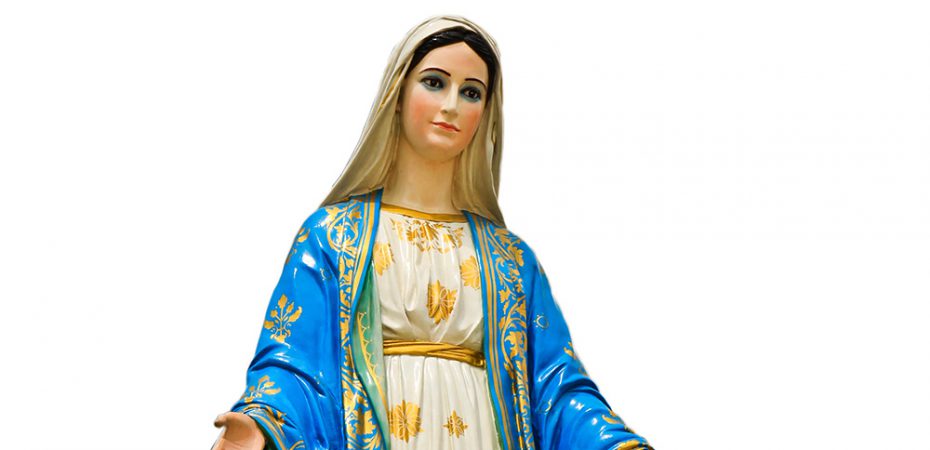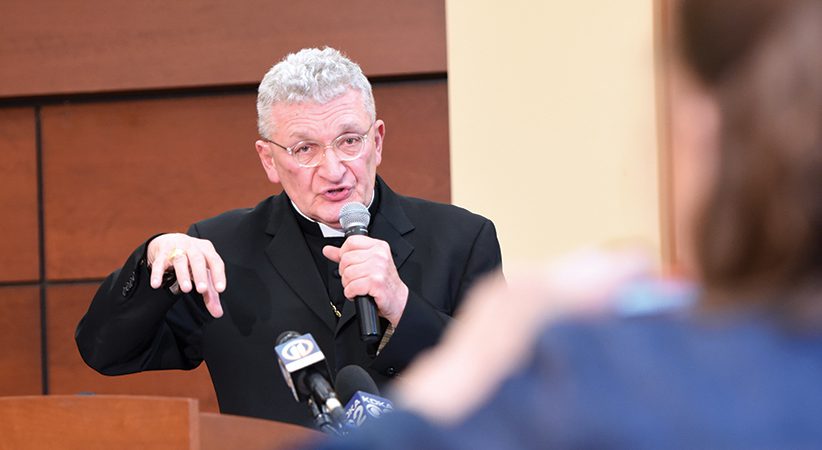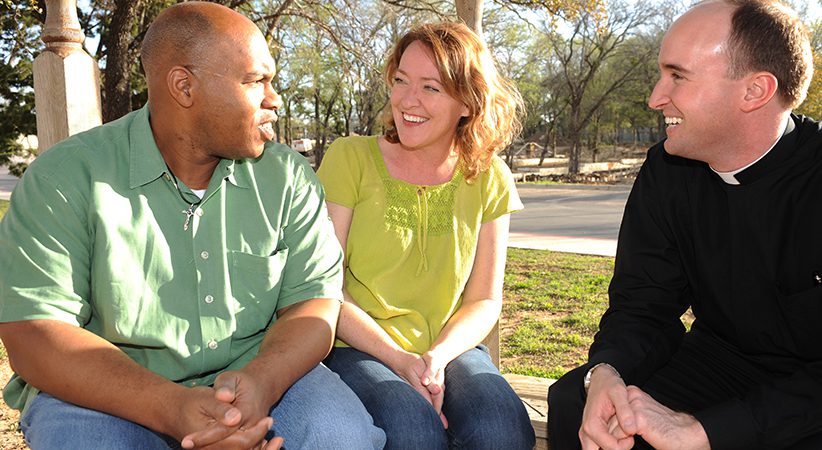Taking Mary as Our Mother
How priests can deepen their devotion to the Virgin Mary — and why it matters
Edward Sri Comments Off on Taking Mary as Our Mother
There is an intimate connection between Mary and priests — one that deeply can enrich one’s priesthood. But is there any scriptural support for this connection? Might the Bible offer any practical insights for priests on how to live their priesthood more in union with Our Lady?
When considering this question in the 2009 Year for Priests, Pope Benedict XVI turned to two scenes in Mary’s life: her fiat at the Annunciation and her standing at the foot of the cross.
Let’s unpack the rich biblical theology in these passages and consider how they offer a Marian pathway to living the priesthood.
Much of this article is excerpted from my book “Rethinking Mary in the New Testament” (Ignatius Press, $17.95).
The Depths of Mary’s ‘Yes’
Pope Benedict first notes how Mary’s “yes” is the door through which God became man, which itself is the foundation preparing for Christ to give himself on the cross and in the Eucharist. Hence, one can see the close connection between Mary’s fiat and the vocation of the priesthood, which participates in Christ’s own priestly sacrifice and makes possible the offering of the body and blood of Christ in the Eucharist. In Pope Benedict’s words, “sacrifice, priesthood and incarnation go together, and Mary is at the heart of this mystery.”

Let’s enter into the heart of Mary’s “yes” at the Annunciation and consider ways it challenges, encourages and inspires priests to live this mystery more profoundly each day in their priesthood.
Put yourself in Mary’s shoes and consider all that has been revealed to her. An angel suddenly appears, greeting her with the words “the Lord is with you,” signaling that something significant is about to be asked of her by God (see Ex 3:12; Jos 1:5, 9; Jgs 6:12; 2 Sm 7:9). Gabriel next informs her that she will conceive and will carry in her womb Israel’s long-awaited Son of David, the Messiah. She will conceive this child not through natural means but by the power of the Holy Spirit. And to top it all off, she’s told that her child will be the holy Son of God. That’s enough to make most people faint. What was going on inside Mary at this moment?
The Bible only gives us one verse that serves as a window into her soul at this moment — that is, her response: “Behold, I am the handmaid of the Lord; let it be to me according to your word” (Lk 1:38).
Mary’s response is utterly unique in all of Scripture. In other birth announcements and commissioning scenes like this, God or his heavenly messenger typically speaks last before departing. Abraham, Sarah, Zechariah and Samson’s parents do not give a grand statement of consent — a fiat — in the biblical narratives of the birth announcements made to them. Neither does Moses or Gideon when God commissions them. But here, Mary remarkably stands out for getting the last word in the dialogue with the angel. And the words themselves reveal much about Mary’s desire to serve God.
First, note how Mary refers to herself as a “handmaiden.” The word in Greek, doule, literally refers to a female slave or servant. The term in its masculine and feminine forms describes someone in a humble position addressing a superior, and it often portrays righteous people when speaking to God (see 1 Sm 1:11; 25:41; 2 Sm 9:6; 2 Kgs 4:16; Ps 86:16).
The title “servant of the Lord” was applied to some of Israel’s great leaders, such as Moses (see Jos 14:7), Joshua (Jos 24:29, Jgs 2:8), David (1 Kgs 8:26; 11:13; Ps 36:1) and Solomon (1 Kgs 8:28, 30). Even the whole nation of Israel was described as the Lord’s servant (Neh 1:6). Mary’s self-description as a female slave of the Lord (doule) echoes most particularly that of Hannah, who, when expressing her humble condition before God, referred to herself as a “handmaid” (doule) of the Lord (1 Sm 1:11). In narrating this title of Mary, Luke underscores how Mary stands in a group of some of Israel’s greatest servants called by the Lord.
But the key takeaway is this: In referring to herself as a slave of the Lord, Mary reveals herself to be someone who places herself completely at God’s disposal. She cooperates with God and allows God to act in her life. She gives God permission to do with her whatever he wants.
Do you live your priesthood in this way? Are you like Mary, listening to God’s words and putting yourself totally at his disposal? Do you ardently seek God’s will for your parish, for your ministry, for the work you do each day? Is your priesthood rooted in prayer, begging God to show you what you are to do each day, listening to his voice like Mary, who kept all things and pondered them in her heart? Or are you frantically running from one meeting to the next, from one event to the next — a fury of activity but not a ministry flowing from a deep interior life?
Some priests might wake up each morning and look at their calendar appointments, make a to-do list or live their days responding to one urgent matter after another. Other priests begin their days like Mary, putting all their planning, all their activities, all their desires for their ministry completely at God’s disposal: “Behold, I am the slave of the Lord.”
Mary’s Fiat
Second, Mary’s concluding words, “Let it be to me” (genoito moi) express a wish or a longing on her part. These are not words of mere submission or resignation. (“Well, I guess I have to do this because the bishop wants me to.”) In this particular grammatical form in ancient Greek, known as the optative, Mary’s “let it be” (genoito) communicates a wish or longing. Biblical scholar Ignace de la Potterie explains this in his book “Mary in the Mystery of the Covenant” (Alba House, 1992):
| To ‘Love and Venerate’ Mary |
|---|
|
“[Priests] will always find a wonderful
example of such docility in the Blessed Virgin Mary, who was led by the Holy Spirit to dedicate herself totally to the mystery of man’s redemption. Let priests love and venerate with filial devotion and veneration
this mother of the Eternal Highpriest, Queen
of Apostles and Protector of their own ministry.”
— Presbyterorum Ordinis, No. 18 |
“The resonance of Mary’s fiat at the moment of the Annunciation is not that of the ‘fiat voluntas tua’ of Jesus in Gethsemane, nor that of a formula corresponding to the Our Father. Here there is a remarkable detail, which has only been noticed in recent years, and which even today is frequently lost from sight. The fiat of Mary is not just a simple acceptance or even less, a resignation. It is rather a joyous desire to collaborate with what God foresees for her. It is the joy of total abandonment to the good will of God. Thus the joy of this ending responds to the invitation to joy at the beginning.”
As such, Mary’s fiat stands as a model for all of us who strive to be faithful disciples. Her example inspires especially priests to be true servants of the Lord, seeking to use their lives not for their own purposes but for the Lord who is their good and loving Master. Her fiat also encourages priests to view obedient discipleship not as mere submission or acceptance of God’s will, but as a joyful longing to run after God’s will in our lives, like a lover wanting to fulfill the desires of the beloved.
‘Behold, Your Mother’
Pope Benedict also turns to the scene at the cross when Jesus puts the Beloved Disciple into a special filial relationship with Mary.

Traditionally, the Beloved Disciple has been identified as the apostle John. But in the Fourth Gospel this character takes on an important symbolic role as well. John’s Gospel often uses individual characters to symbolize larger groups. Nicodemus, for example, is described as “a man of the Pharisees” and a “ruler of the Jews” who comes to Jesus by night and does not understand Jesus’ teachings (see Jn 3:1).
Nicodemus thus represents the many Pharisees and other Jewish leaders who do not understand Jesus and who, like Nicodemus, find themselves in the dark when it comes to Jesus’ teachings. The Samaritan woman in John 4 is another individual who represents a larger group. She has trouble grasping Jesus’ teaching and identity but later comes to faith. As such, she can be seen as representing the many Samaritans who have fallen away from Judaism but will come to believe in Christ.
The Beloved Disciple represents the ideal disciple. It is the Beloved Disciple who is close to Jesus, leaning on his master’s breast at the Last Supper (see Jn 13:25). He is the only apostle to remain with Jesus at the cross on Good Friday, the first to believe in Christ’s resurrection (Jn 20:8) and the first to bear witness to the Risen Christ’s lordship (Jn 21:7, 24).
While the Beloved Disciple traditionally is identified as John, he also represents all disciples who faithfully follow Christ, even in the face of suffering and the cross, and who believe in Jesus and bear witness to him as Lord.
Mary’s Spiritual Motherhood
This has important implications for understanding Mary’s role in the Christian’s life, and thus also for priests. In Jesus’ last act before he dies, he entrusts this Beloved Disciple to Mary. On a basic level, this simply indicates that the Beloved Disciple has a special relationship with Mary now, like that of a son with his mother. But on a deeper spiritual level, this passage can offer important biblical support for the doctrine of Mary’s spiritual motherhood of all Christians (see Catechism of the Catholic Church, Nos. 968-970). In John 19, Mary becomes the mother of the Beloved Disciple, but since the Beloved Disciple represents all faithful disciples, we can conclude that Mary in some sense is put into a special maternal relationship with all the followers of Jesus who are represented by the Beloved Disciple, all those who have “believed in his name,” have been “born anew” and “made children of God” (see John 1:12; 3:3).
Reflecting on this passage, Pope St. John Paul II in a 1997 general audience explains that although Jesus does not explicitly present Mary as spiritual mother of all Christians, the passage does point us to this reality:
“Jesus’ words ‘Behold your son’ effect what they express, making Mary the mother of John and of all the disciples destined to receive the gift of divine grace. On the cross Jesus did not proclaim Mary’s universal motherhood formally, but established a concrete maternal relationship between her and the Beloved Disciple. In the Lord’s choice we can see his concern that this motherhood should not be interpreted in a vague way, but should point to Mary’s intense, personal relationship with individual Christians. May each one of us, precisely through the concrete reality of Mary’s universal motherhood, fully acknowledge her as our own Mother and … commend ourselves to her maternal love.”
……………………………………………………………………………………………………………………………………………………………
Mary, Mother of All Priests
During the Year for Priests in 2009, Pope Benedict XVI dedicated the address at his Aug. 12 general audience, given at Castel Gandolfo, to Mary’s connection with the priesthood. He said:
“Mary loves them with predilection for two reasons: because they are more like Jesus, the supreme love of her heart, and because, like her, they are committed to the mission of proclaiming, bearing witness to and giving Christ to the world. Because of his identification with and sacramental conformation to Jesus, Son of God and Son of Mary, every priest can and must feel that he really is a specially beloved son of this loftiest and humblest of Mothers. …
“Dear brothers and sisters, let us pray that Mary will make all priests, in all the
problems of today’s world, conform with the image of her Son Jesus, as stewards
of the precious treasure of his love as the Good Shepherd. Mary, Mother of priests,
pray for us!”
…………………………………………………………………………………………………………………………………………………………..
Taking Mary Home?
Finally, let’s consider three points from the last sentence of this scene that tell us about the way the Beloved Disciple accepted Mary as his spiritual mother: “And from that hour the disciple took her into his home” (Jn 19:27)
First, the words “from that hour” could simply have a temporal meaning, pointing to a particular moment when the Beloved Disciple took Mary. But given the major theme of Jesus’ hour throughout John’s Gospel — a theme that is significantly in the background of this scene at the cross (see Jn 12:22-31) — “from that hour” alludes to Christ’s supreme hour of self-giving love on the cross and his victory over the devil. The implication now is that Christ’s redemptive work on Calvary is complete; the Beloved Disciple can “take her into his home.”
But, second, what does it mean for the Beloved Disciple to “take” Mary? In John’s Gospel, the Greek word for “take” (lambano) has three shades of meaning. When associated with a physical object, lambanō refers to physically taking something, such as loaves of bread (“Then Jesus took the loaves” [Jn 6:11]). When associated with a spiritual gift, however, the word does not imply taking in the sense of physically moving something to seize it. Instead it means “to receive,” as in receiving grace (see Jn 1:16) or receiving the Holy Spirit (Jn 20:22).
In yet another case, when the word lambano is associated with a person, it means to receive someone personally — to welcome, accept or believe that person. In John’s Gospel, this third sense is often used to express someone welcoming Christ in faith (Jn 1:12; 5:43; 13:20).
Because our scene at the cross in John 19:27 uses “took” (lambano) in reference to the person of Mary, this third personal meaning is most likely in play here. Consequently, when Scripture says that the Beloved Disciple “took” Mary, this does not mean merely that he took her on a journey to a specific place. Rather, it denotes a personal welcoming of the Blessed Mother into his life. Recall that Jesus just put the Beloved Disciple in a new son-mother relationship with Mary (“Behold, your mother!”). Thus the Beloved Disciple “taking” (lambano) Mary points to his joyful acceptance of Our Lady in this new relationship as he welcomes her as his mother. St. John the Apostle models for all priests the joyful welcoming Our Lady deserves in their hearts.
Welcoming Our Mother
What does it mean that “the disciple took her into his home”? Though the last words commonly are translated “to his own home,” the New American Bible used by the Church has it correct, as the expression in the original Greek more literally means “into his own” or “into the things that were his own.” In fact, John’s Gospel uses this expression to describe Jesus’ own people (see 1:11), his own sheep (10:4) and his own disciples (13:1). Especially in John 13, the words “his own” describe a deep, personal communion with his disciples.
Therefore, the account of the Beloved Disciple receiving Mary into “his own” does not likely refer to his merely taking her to his house. John’s Gospel is concerned with something more profound than where Mary went to live. Rather, the Beloved Disciple taking Mary into “his own” points to something deeper, something more spiritual. The Beloved Disciple welcomes Mary into a profound, personal communion, fully embracing the mother of Jesus as his own mother. He welcomes Mary as one of “his own.”
Pope St. John Paul II in his 1997 general audience on the Theotokos has further spiritual insight into this scene. He notes that the words “into his own” refer in John’s Gospel to “the spiritual goods or gifts received from Christ: grace (Jn 1:16), the word (Jn 12:48; 17:8), the Spirit (Jn 7:39; 14:17), the Eucharist (Jn 6:32-58).”
He then concludes that the Beloved Disciple, in welcoming Mary “into his own,” recognizes Mary as a great spiritual gift given to Christ’s followers. By taking Mary “into his own,” the Beloved Disciple welcomes Mary not simply as a mother but as a spiritual mother who represents a profound spiritual gift to his interior life. Just as a faithful disciple welcomes the word, the Spirit or the Eucharist into his spiritual life, so does the Beloved Disciple welcome Mary’s spiritual maternity as a treasure given to him by Our Lord. St. John Paul II exhorts us to make room for Mary in our own lives, just as the Beloved Disciple did in his:
“Among these gifts which come to him from the fact that he is loved by Jesus, the disciple accepts Mary as his mother, establishing a profound communion of life with her. May every Christian, after the Beloved Disciple’s example, ‘take Mary into his house’ and make room for her in his own daily life, recognizing her providential role in the journey of salvation.”
| ‘Rethinking Mary in the New Testament |
|---|
Pope Benedict notes the same is true especially for priests: “To take Mary with one means to introduce her into the dynamism of one’s own entire existence — it is not something external — and into all that constitutes the horizon of one’s fundamental reason for her special love for each of them.”
This reminds us of what the Second Vatican Council taught in Presbyterorum Ordinis: “Priests should always venerate and love her, with a filial devotion and worship” (No. 18). Devotions like the daily Rosary, traditions like the May crowning, singing the Salve at the end of Mass or doing something special to celebrate Marian feast days are examples of small ways we can show love for Our Lady. Turning to her in moments of difficulty by praying a simple Hail Mary, a Memorare or a decade of the Rosary are other ways of growing closer to her.
The smallest acts of love and devotion will bear tremendous fruit in a priest’s ministry. For as St. Andrew of Crete once said to Mary, “You who are most bountiful, do return great favors for small services.” Indeed, this point also was well-expressed in the words of the 17th-century Camaldolese hermit Dom Roberto: “Even the least service done her, the least act of respect to her, is rewarded a thousandfold in this life and the next.”
May all priests find the tremendous blessings that await them if they offer the Blessed Virgin Mary the least services of devotions. May they embrace Our Lady as their spiritual mother and, like the Beloved Disciple, lovingly take Mary “into their own.”
EDWARD SRI, S.T.D., is a theologian and well-known Catholic speaker and the author of several best-selling books. He is vice president of formation for FOCUS (Fellowship of Catholic University Students).
Prayer for Priests
O Mary,
Mother of Jesus Christ and Mother of priests,
accept this title which we bestow on you
to celebrate your motherhood
and to contemplate with you the priesthood
of, your Son and of your sons,
O holy Mother of God.

O Mother of Christ,
to the Messiah-priest you gave a body of flesh
through the anointing of the Holy Spirit
for the salvation of the poor and the contrite of heart;
guard priests in your heart and in the Church,
O Mother of the Savior.
O Mother of Faith,
you accompanied to the Temple the Son of Man,
the fulfillment of the promises given to the fathers;
give to the Father for his glory
the priests of your Son,
O Ark of the Covenant.
O Mother of the Church,
in the midst of the disciples in the upper room
you prayed to the Spirit
for the new people and their shepherds;
obtain for the Order of Presbyters
a full measure of gifts,
O Queen of the Apostles.
O Mother of Jesus Christ,
you were with him at the beginning
of his life and mission,
you sought the Master among the crowd,
you stood beside him when he was lifted
up from the earth
consumed as the one eternal sacrifice,
and you had John, your son, near at hand;
accept from the beginning those
who have been called,
protect their growth,
in their life ministry accompany
your sons,
O Mother of Priests.
Amen.
— From Pastores Dabo Vobis, Pope St. John Paul II, 1992






